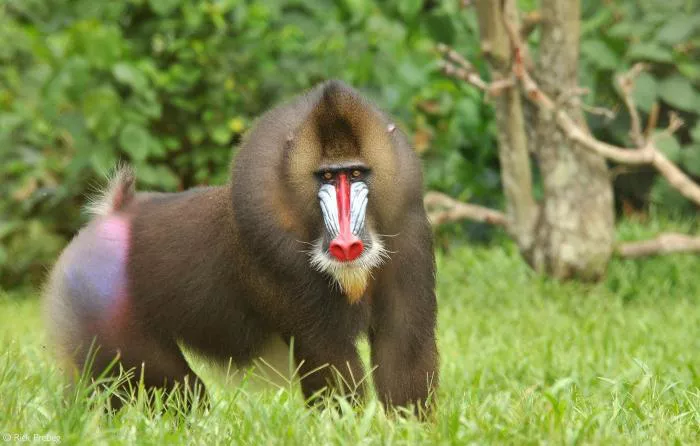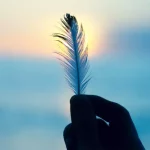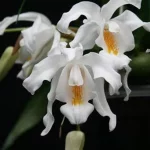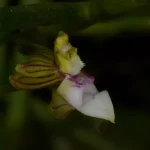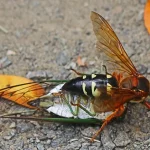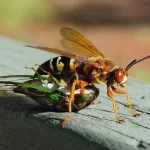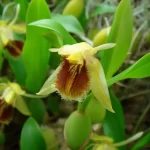The mandrill, an impressive primate belonging to the genus Mandrillus, is often revered for its striking appearance and intriguing behavior. Known for its vibrant facial colors, muscular build, and formidable presence, the mandrill has been a subject of fascination across cultures. The symbolism of the mandrill varies widely depending on geographic region, cultural beliefs, and its representation in folklore. In this article, we will explore the mandrill’s spiritual meaning, its symbolism in different countries, the significance of its colors, its representation in dreams, and the myths and legends associated with this extraordinary creature.
Mandrill Spiritual Meaning
The mandrill holds a significant place in the spiritual traditions of many cultures, with its symbolism often reflecting strength, wisdom, and mystery. In spiritual contexts, the mandrill is frequently associated with primal energy, courage, and the power of transformation.
Primal Energy and Strength
Mandrills are some of the largest monkeys, with powerful physiques and an intimidating presence. In many spiritual traditions, animals like the mandrill that display raw physical power symbolize the importance of grounding oneself in the physical world. The mandrill’s sheer strength and resilience often represent overcoming challenges, standing firm in the face of adversity, and drawing strength from the Earth. The mandrill teaches us to harness our own primal energy and use it to create positive change in our lives.
Wisdom and Intelligence
Despite their tough exterior, mandrills are also highly intelligent creatures. Their ability to communicate, solve problems, and interact with their environment has earned them a place as symbols of intellect. The mandrill’s wisdom is often connected to learning from one’s experiences, making wise choices, and using one’s intelligence to navigate life’s challenges. In spiritual practices, the mandrill may represent the balance between brawn and brain, reminding us that true strength lies in the combination of both physical and mental prowess.
Transformation and Renewal
In many spiritual traditions, animals are seen as messengers of transformation. The mandrill’s striking appearance, especially its colorful face, is often viewed as a sign of the vibrant changes that can occur in one’s life. The colors on its face change depending on the individual’s mood and social interactions, symbolizing the fluidity and dynamism of life. As such, the mandrill can represent periods of personal growth, renewal, and transformation.
Mandrill Symbolism (In Different Countries)
Mandrills are found primarily in the rainforests of West Africa, and their symbolism varies significantly between cultures and regions. Below, we explore how different countries interpret the symbolism of the mandrill.
African Symbolism
In Africa, where the mandrill is native, the creature is often revered as a powerful symbol of both spiritual and physical strength. Many African tribes view the mandrill as a symbol of leadership and guardianship. The mandrill’s role in African folklore and traditions often associates it with the spirits of ancestors and the strength of the Earth.
In some African cultures, the mandrill is seen as a protector of the forest, embodying the primal energy of the natural world. As such, it represents the link between humans and nature, as well as the deep spiritual connection that people have with the land.
Central and South American Symbolism
While the mandrill is not native to Central and South America, its presence in zoo environments and its association with other primates like baboons often give it a place in the cultural mythology of these regions. In some cultures, the mandrill is linked to the symbolism of trickster gods and mischievous spirits. The bright colors of its face, especially its red and blue markings, are sometimes seen as representations of duality and balance, a theme common in many indigenous belief systems.
In some South American myths, the mandrill represents the animalistic side of human nature, emphasizing the tension between our wild instincts and our need for order and civilization.
Western Symbolism
In Western cultures, the mandrill is not as commonly known as some other animals, but it still carries symbolic weight. The mandrill’s powerful appearance often evokes a sense of awe and respect. In modern Western spirituality, the mandrill may symbolize the need to reconnect with our inner strength and the untapped potential that lies within us. The colorful face of the mandrill, which can change to reflect its mood, is sometimes interpreted as a reminder to be authentic and true to ourselves, acknowledging both our light and dark sides.
Mandrill Symbolism (With Different Colors)
One of the most distinctive features of the mandrill is its vividly colorful face. The blue, red, and yellow hues are not only striking but also carry symbolic meaning in various cultures. Understanding the colors of the mandrill’s face and their associated meanings can provide deeper insights into its symbolism.
Red: Passion, Strength, and Emotion
The red coloration on the mandrill’s face is one of the most prominent features and is often associated with strong emotions. Red is universally regarded as a symbol of passion, vitality, and courage. In the case of the mandrill, the red may represent the raw energy and fiery spirit that it possesses. It also symbolizes strong emotions like anger, love, and determination.
Red can also represent vitality and life force. In spiritual terms, the color red is often linked to the root chakra, which governs stability, strength, and survival instincts. For those who connect with the mandrill, the red may indicate the need to tap into one’s base energies for survival or growth.
Blue: Calm, Wisdom, and Communication
The blue coloration on the mandrill’s face is equally significant. Blue is a color that is often associated with calmness, wisdom, and communication. In many spiritual traditions, blue represents clarity of thought and the ability to express oneself truthfully. The blue markings on the mandrill’s face can thus symbolize the importance of clear communication and wisdom in relationships.
In some cultures, blue is also associated with the throat chakra, the center of communication. This suggests that the mandrill, with its blue features, may symbolize the importance of speaking one’s truth and ensuring that one’s voice is heard in the world.
Yellow: Energy, Renewal, and Creativity
The yellow around the mandrill’s face is often linked to the solar plexus chakra, which governs personal power, creativity, and energy. Yellow is a vibrant color that evokes feelings of joy, optimism, and renewal. The yellow coloration on the mandrill can thus represent a burst of creative energy, a time for new beginnings, or the ability to manifest one’s desires into reality.
Yellow is also a symbol of mental clarity and enlightenment. The mandrill’s yellow features may indicate a need for clarity of thought or a new perspective on life. It is a color that encourages personal growth and the pursuit of one’s passions.
See also: 45 Mandrill Quotes, Sayings, and Proverbs
Mandrill Symbolize in Dreams
Dreams about animals can carry powerful messages and symbolism, and the mandrill is no exception. When a mandrill appears in a dream, it can be interpreted in various ways, depending on the context and the feelings experienced during the dream.
Strength and Courage
If you dream of a mandrill, it may be a sign that you need to tap into your own strength and courage. The mandrill’s physical power and intimidating presence in your dream could indicate that you are about to face a challenging situation where you will need to rely on your own abilities to overcome obstacles.
Emotional Clarity
Because of the colorful nature of the mandrill’s face, dreams involving this animal may be a reminder to pay attention to your emotions. The dream could be prompting you to examine your emotional state more closely, encouraging you to confront repressed feelings or recognize the power of your emotional intelligence.
Personal Transformation
Dreaming of a mandrill may also symbolize a period of personal transformation. Just as the mandrill’s appearance changes based on its mood, your dream may indicate that you are going through a phase of significant change or growth. This change may involve developing new strengths, gaining wisdom, or letting go of outdated beliefs.
THE Myths and Legends About Mandrill
Mandrills, like many animals, are the subject of various myths and legends across different cultures. These stories often reflect the mandrill’s association with strength, intelligence, and its connection to both the physical and spiritual realms.
African Myths
In many African myths, the mandrill is revered as a guardian of the forest and an embodiment of ancestral spirits. Some stories depict the mandrill as a wise figure who provides guidance to those who seek it. In others, it is a symbol of the powerful spirits that reside in nature, acting as a protector of the balance between humans and the Earth.
Trickster Legends
In some cultures, particularly in Central and South America, the mandrill is seen as a trickster figure. These legends portray the mandrill as a mischievous character who uses its cleverness to outwit others. The bright colors on the mandrill’s face are sometimes linked to the dual nature of the trickster, reflecting the balance between good and evil, light and dark, that exists in the world.
The Mandrill as a Symbol of Renewal
In certain African folklore, the mandrill is associated with renewal and rebirth. It is believed that the mandrill’s vibrant colors represent the cycles of life and the constant flow of energy in nature. As the mandrill changes its appearance, it symbolizes the ever-changing nature of life itself—reminding us that life is constantly evolving, and with each new cycle, there is the possibility for growth and transformation.
Conclusion
The mandrill is a powerful symbol, rich in meaning and significance across different cultures. Whether representing strength, wisdom, emotional clarity, or personal transformation, the mandrill teaches us valuable lessons about resilience, self-expression, and connection to the natural world. Through its vibrant colors, its role in myths and dreams, and its symbolism in various cultural contexts, the mandrill continues to captivate our imaginations, urging us to tap into our inner strength, embrace change, and live authentically.
Related topics:

